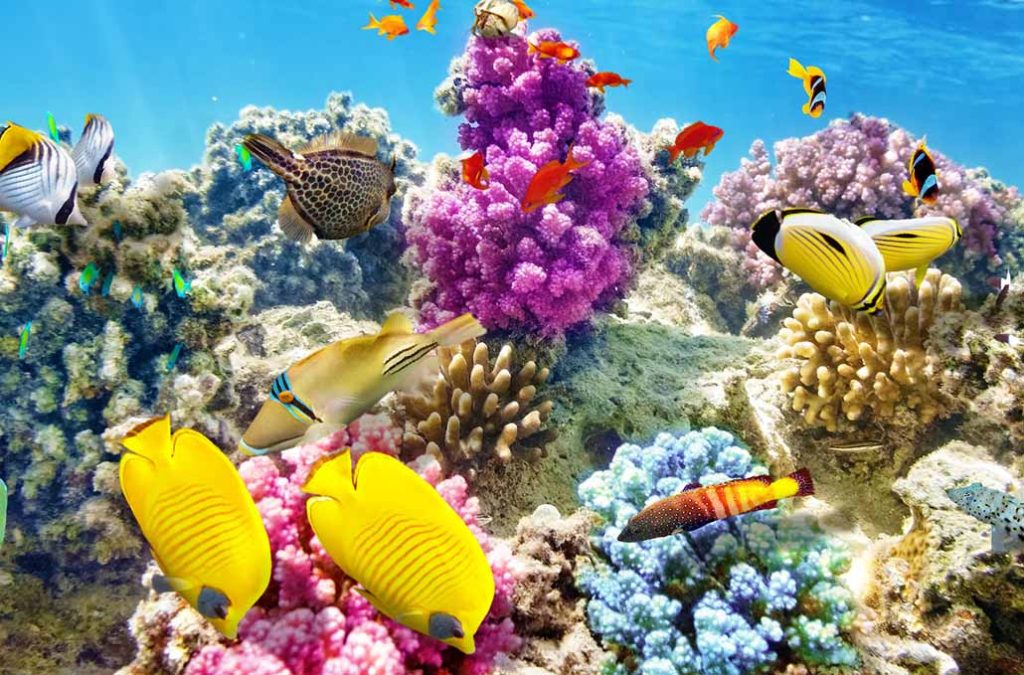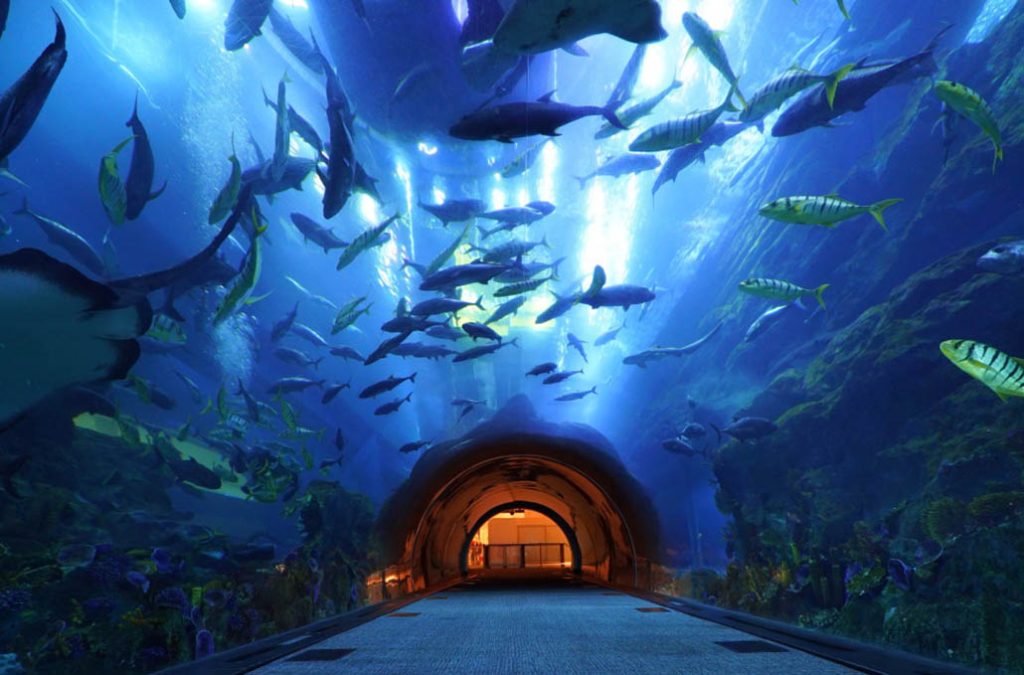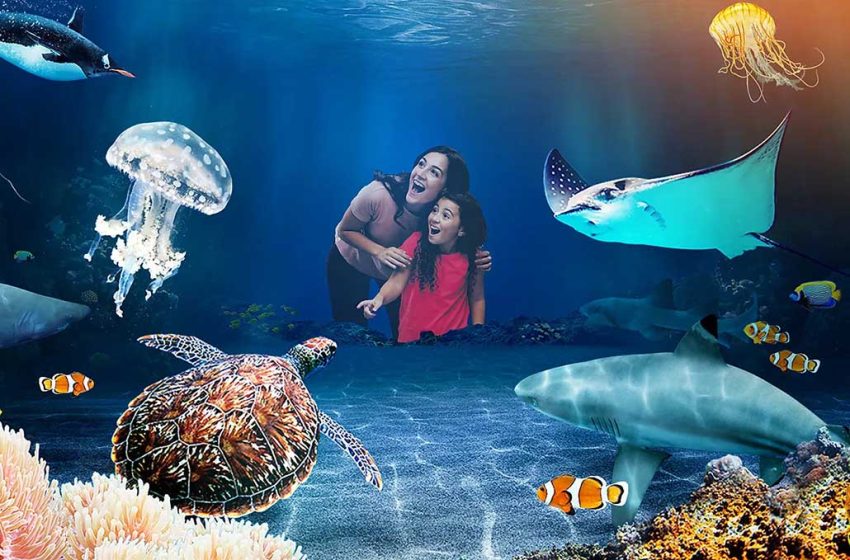1. Immersive Adventure: Entering SEA LIFE’s Aquatic Paradise
Stepping through the softly glowing blue entrance feels like crossing into another dimension. The floor beneath your feet mimics the texture of ocean waves, while gentle ripples of light dance across the walls, as if the sea itself is flowing around you. With 50 aquariums, 2 marine sanctuaries, and over 180,000 creatures, SEA LIFE brings visitors closer to the ocean than ever before. Every element around you whispers that this is not just an exhibition—it’s the living, breathing world beneath the sea.
Through expansive curved viewing windows, vibrant coral reefs and uniquely shaped tropical fish drift effortlessly. Sunlight filters through the surface, refracting into a kaleidoscope of colors that gently illuminates faces pressed against the glass. Soft sounds of flowing water and the subtle movements of marine creatures fill the air, transporting the mind to a place of both peace and wonder. On either side of the walkways, transparent tunnels arc overhead, forming undersea corridors where dolphins and sharks glide overhead. Beneath a dome of deep blue, schools of fish seem to swim right past your fingertips—close enough to touch, yet floating in serene silence.
2. The Brilliant Palette of the Coral Forest
The coral reef section unveils a living forest beneath the waves, full of vivid life and color. This zone showcases over a hundred species of hard and soft corals—some shaped like wrinkled brains, others blooming like underwater flowers, while feather-like corals fan out gracefully with the currents. SEA LIFE meticulously replicates natural coral environments, balancing water temperature, salinity, and lighting to ensure the healthy growth of every coral specimen.
A closer look reveals entire micro-ecosystems nestled among the coral. Tiny shrimp blend into the crevices, their colors matching the coral with astonishing precision. Hermit crabs scurry with borrowed shells, their legs a blur of energy. Occasionally, a clownfish darts between anemone tentacles, tracing a path that seems instinctively familiar. Zooming in on a swaying sea anemone, one can make out the stinging cells at the tips of its tentacles, delicate and mesmerizing like an aquatic ballet. Standing before the display, it’s easy to imagine the feel of the water, the gentle tug of the currents—everything feels achingly close.

3. The Majestic Power of Deep-Sea Giants
Leaving the shallow coral habitats behind, the transition into the deep-sea gallery is striking. The environment dims dramatically, with green-blue lights casting their glow on a massive central tank. Whale sharks, slow and immense, glide past like living constellations. Their spotted backs resemble the night sky, and upon closer inspection, their skin is dotted with rough, resilient textures—a perfect adaptation for life in shifting currents. They feed with their mouths wide open, filtering plankton from the water as if chanting in slow, silent tones.
Nearby, giant manta rays move as if flying underwater. Their broad wings beat rhythmically, creating whirlpools that stir the sand below like a starry dust storm. The piranha enclosure presents a stark contrast—flashes of red and silver, illuminated by sharp lighting, highlight rows of razor-sharp teeth. Soft thuds echo as they shift rapidly, sparking a twinge of tension. With 50 aquariums, 2 marine sanctuaries, and over 180,000 creatures, SEA LIFE gives an up-close look at the sheer scale and ferocity of the ocean’s largest and most enigmatic dwellers.
4. The Surreal Beauty of the Micro Underwater World
Peering into SEA LIFE’s microscopic exhibit is like stepping into an entirely different universe. Under high-powered lenses, strands of sea grass reveal intricate vein patterns. Tiny creatures such as rotifers spin in place, their cilia forming miniature whirlpools. Phytoplankton shimmer green under the light, like nebulae drifting through a galactic sea.
Interactive high-definition displays allow guests to switch perspectives—zooming in to see the mutualistic relationships between coral polyps and algae. On-site marine scientists explain the imaging and chemical analysis techniques used to unlock the secrets of this hidden world. With cutting-edge technology and detailed biological models, SEA LIFE showcases not only the aesthetics of the micro-sea but also the ecological intricacies that sustain it. Every microscopic grain of sand becomes a stage for complex, interwoven life forms.
5. A Gentle Encounter with Sea Turtles
In the warm, shallow zone, a few gentle sea turtles glide through the turquoise waters, lazily extending their limbs. Their shells are marked by time—scarred and weathered like ancient armor. Young children press against low glass walls, reaching out in awe, though safely separated. Professional guides softly narrate the turtles’ life cycles, from hatching on distant shores to their years-long migrations across entire oceans.
With 50 aquariums, 2 marine sanctuaries, and over 180,000 creatures, SEA LIFE offers encounters that feel as personal as they are educational. Light projections reflect moving waves onto the surface of touch pools. As turtles pass beneath, ripples flicker on surrounding surfaces, like scenes from an oceanic dream. Through interaction and story, visitors gain more than a close-up view—they gain understanding. The importance of habitat protection, turtle migration patterns, and human impact is woven into every gentle stroke of a flipper.
6. Discovering the Ocean’s Deepest Mysteries
The deeper you go, the stranger life becomes. The bioluminescence zone at SEA LIFE glows with alien elegance. Firefly squid and lanternfish glitter under darkened water, each flash a survival signal in the abyss. Octopuses stretch tentacles from rocky hollows, skin shifting instantly between camouflage textures. SEA LIFE, with its 50 aquariums, 2 marine sanctuaries, and over 180,000 marine creatures, brings these elusive beings into the light.
One of the most captivating exhibits features deep-sea fungi—soft, gelatinous organisms with translucent petals that sway like crystalline flowers. These light-sensitive creatures pulse with natural iridescence under targeted lamps. Guests watch in awe as built-in sensors reveal how these organisms use light as a lure or form of communication. It becomes a living symphony of bioluminescence, composed in an alien world we barely understand.
7. Child’s First Conversation with the Ocean
In the children’s discovery area, hands-on learning turns curiosity into connection. Kids craft illustrated marine guides, guided by models of seashells, starfish, and urchins. By touching, assembling, and coloring, they learn shapes and species through all five senses.
One standout activity is “Dancing with Sharks”—a safe and thrilling encounter behind reinforced glass, where children get a close-up look at the muscle ripples and toothy grins of these apex predators. SEA LIFE’s immersive educational experiences, supported by its 50 aquariums, 2 sanctuaries, and 180,000+ creatures, help turn passive viewers into engaged learners. Through discovery, play, and vivid storytelling, a new generation of ocean lovers is born.
8. A Nocturnal Journey Beneath the Waves

As evening falls, select SEA LIFE locations offer after-dark experiences. House lights fade to purples and soft blues, replicating moonlit seas. Fluorescent corals glow in darkness, and nocturnal fish swim like streaks of light across shadowy tanks. Some rare exhibits open only at night—such as deep-sea predators like the viperfish or gulper eel, who hunt in absolute blackness.
Visitors don night-vision goggles to spot luminous shrimp and stealthy squid. In the serene “Midnight Ocean Meditation” sessions, guests sit beside water screens, enveloped in the sounds of the sea—whale songs, tectonic vibrations, and the rhythmic ebb and flow of tides. It’s a sensory voyage into the hidden pulse of ocean life.
9. Marine Conservation: SEA LIFE’s Ongoing Mission
Beyond the displays and entertainment, SEA LIFE integrates conservation into every experience. Interactive panels share real-time data on plastic waste, coral bleaching, and ecosystem restoration. With augmented visuals and lifelike models, visitors understand the stakes—and the power of action.
At the on-site sanctuaries, hands-on activities include coral planting and sea turtle release. SEA LIFE, with its 50 aquariums, 2 marine sanctuaries, and 180,000+ animals, transforms passive viewing into active stewardship. Whether gently placing coral seedlings into new reef plots or helping a young turtle return to the sea, every act becomes part of a greater narrative: that of protecting the oceans we all rely on.
10. Planning Your Underwater Journey
Planning makes the experience even more immersive. Tickets, nighttime tours, and conservation activities can be booked in advance through SEA LIFE’s official website. Each location has its own unique attractions—spend the morning in the vibrant coral reefs, the afternoon marveling at deep-sea giants, and the evening immersed in glow-in-the-dark exhibits or kid-friendly workshops.
Most SEA LIFE centers are easily accessible, located near city hubs or major tourist routes. Many sanctuaries offer eco-shuttle services, making travel easier and greener. Digital maps and mobile apps help track exhibit times and locations, so no moment is missed. Pack a camera, a notebook, and a curious spirit—because once you’ve experienced SEA LIFE, every breath starts to feel just a little more connected to the ocean.

